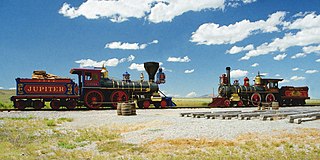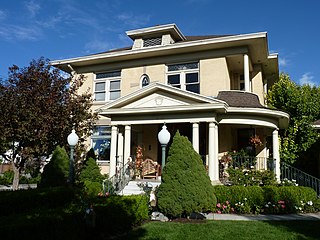
Golden Spike National Historical Park is a United States National Historical Park located at Promontory Summit, north of the Great Salt Lake in east-central Box Elder County, Utah, United States. The nearest city is Corinne, approximately 23 miles (37 km) east-southeast of the site.

The Utah Territorial Statehouse, officially Territorial Statehouse State Park Museum, is a state park in Fillmore, Utah, preserving the original seat of government for the Utah Territory. Built from 1852 to 1855, the statehouse was initially intended as a larger structure, but only the south wing was completed before the project was abandoned due to lack of federal funding, and the Utah Territorial Legislature met in the building only once before the capital was moved to Salt Lake City in 1856.

The Reed Smoot House, also known as Mrs. Harlow E. Smoot House, was the home of Reed Smoot from 1892 to his death in 1941, and is located at 183 E. 100 South, Provo, Utah, United States. Smoot was a prominent US Senator best known for advocacy of protectionism and the Smoot–Hawley Tariff Act.

This is a list of the National Register of Historic Places listings in Sevier County, Utah.
The historic building now operated as the restaurant Jakes Chaparral had a number of prior uses including Kanab Lodge, Parry Cafeteria, Utah Parks Building and Wok Inn restaurant in Kanab, Utah, USA. The original section of the lodge is a house built in 1885, which was expanded between 1928 and 1932 by the Utah Parks Company to serve as a rest stop for tourists about halfway between the north rim of the Grand Canyon and Zion or Bryce Canyon National Parks.

The George Taylor Jr. House is a historic house located at 187 North 400 West in Provo, Utah, United States. It is listed on the National Register of Historic Places.

The Thomas N. Taylor House is a historic house located at 342 North 500 West in Provo, Utah. It is listed on the National Register of Historic Places.

The Simon Peter Eggertsen Sr. House is a historic house in Provo, Utah, United States. It is listed on the National Register of Historic Places. Now it has been repaired, repainted, and appointed with appropriate furnishings of the times, this home very much depicts pioneer design and craftsmanship. The Simon Peter Eggertsen Sr. House was designated to the Provo City Historic Landmarks Registry on March 7, 1996.

The George M. Brown House is a historic residence in Provo, Utah, United States, that is listed on the National Register of Historic Places. It was built as a home for a "polygamous wife" of lawyer George M. Brown. It is listed on the National Register of Historic Places.

The Peter Wentz House is a historic building located in northern downtown Provo, Utah, United States. It is listed on the National Register of Historic Places.

The Startup Candy Company is the oldest candy company in Utah and one of the oldest candy companies in the United States. William Startup started making candy in his basement in Manchester, England in 1820. He developed the first hard candy and called it “American Cough Candy” because he hoped to bring his new recipe to America one day. However, William died before making it to America, but he left his legacy to his son and namesake. William Startup Jr. learned the candy-making process as a young boy and continued to run his father’s candy business.

The George Bonner Jr. House is a historic residence in Midway, Utah, United States, that is listed on the National Register of Historic Places.

The Carter–Terry–Call House on East 800 South in Orem, Utah, United States is believed to have been built in 1899. It was listed on the National Register of Historic Places (NRHP) in 1998.

The Cordner–Calder House at 305 S. 900 E. in Orem, Utah is a Victorian-style house which was built in 1894 by William Cordner and was expanded around 1910. The home is associated with two families, the Corders and the Calders, both of which were "prominent fruit growers on the Provo Bench" whose "participation and influence in the growth of Orem is reflected in this house".

The Christopher F. Dixon Jr. House is a historic house located in Payson, Utah, United States. It was listed on the National Register of Historic Places on November 7, 1977.
Alexander Thomas "Scotty" Boyter was an American stonemason and builder who was active in Beaver, Utah. He is known for his use of local "pink tuff" rock, and several of his works are listed on the National Register of Historic Places. His brother James Boyter also was a mason and they sometimes worked together.
John James Hill (1853–1932), known as John J. Hill, was born in Leicester, England. He was a stonemason and builder in Utah and Nevada in the United States.
Frederick Albert Hale was an American architect who practiced in states including Colorado, Utah, and Wyoming. According to a 1977 NRHP nomination for the Keith-O'Brien Building in Salt Lake City, "Hale worked mostly in the classical styles and seemed equally adept at Beaux-Arts Classicism, Neo-Classical Revival or Georgian Revival." He also employed Shingle and Queen Anne styles for several residential structures. A number of his works are listed on the U.S. National Register of Historic Places.

The Hurricane Canal is a hand-excavated irrigation canal that diverted water from the Virgin River to the east side of Hurricane, Utah, United States.

The Lemuel H. Redd Jr. House is a historic house in Bluff, Utah. It was built in 1900 for Lemuel H. Redd Jr., a Mormon settler, landowner and politician who served as a member of the Utah State Legislature from 1898 to 1902.

















